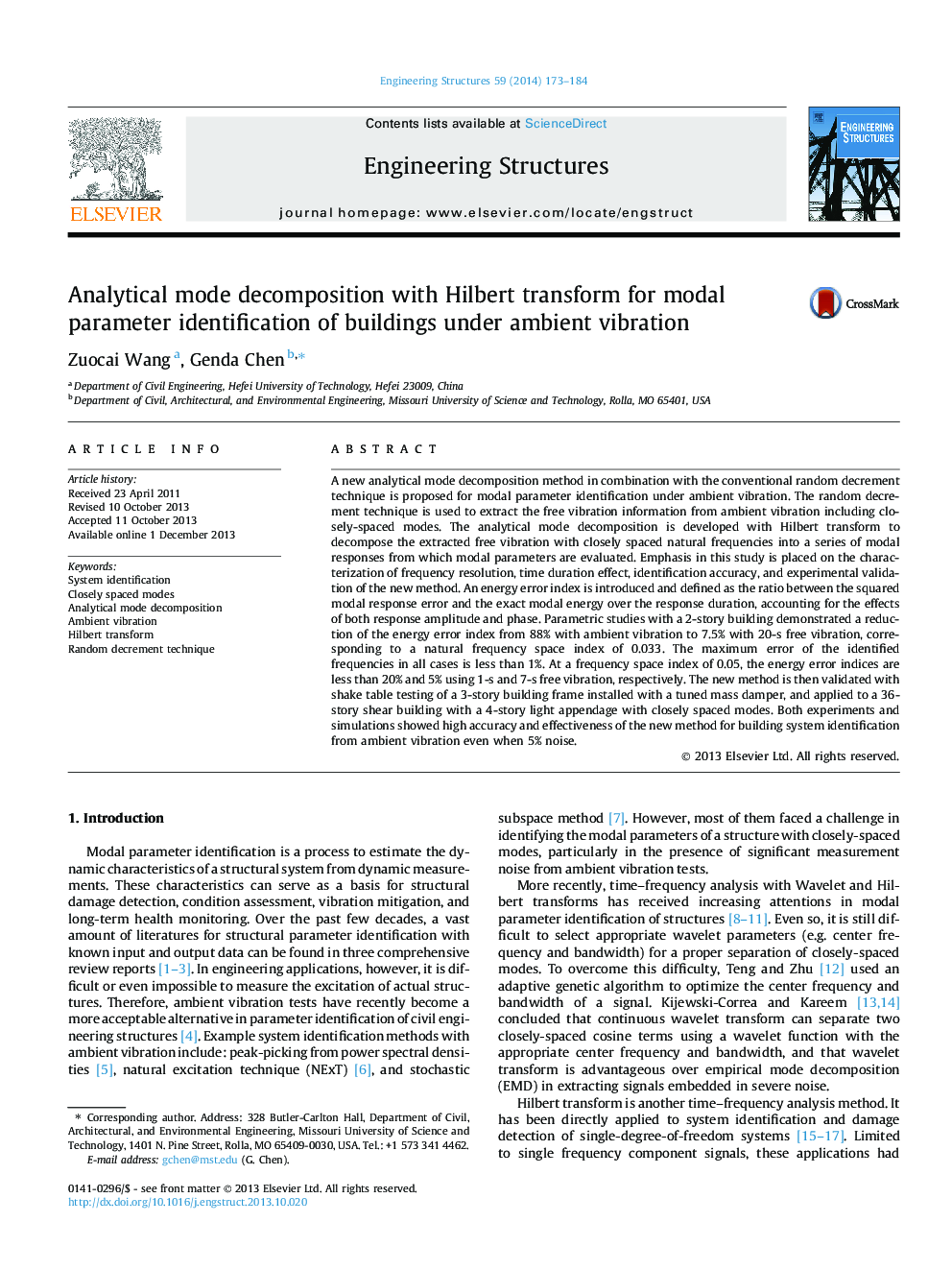| کد مقاله | کد نشریه | سال انتشار | مقاله انگلیسی | نسخه تمام متن |
|---|---|---|---|---|
| 6740830 | 504385 | 2014 | 12 صفحه PDF | دانلود رایگان |
عنوان انگلیسی مقاله ISI
Analytical mode decomposition with Hilbert transform for modal parameter identification of buildings under ambient vibration
ترجمه فارسی عنوان
تجزیه حالت تحلیلی با تبدیل هیلبرت برای شناسایی پارامترهای معینی ساختمان ها تحت لرزش محیط
دانلود مقاله + سفارش ترجمه
دانلود مقاله ISI انگلیسی
رایگان برای ایرانیان
کلمات کلیدی
شناسایی سیستم، حالت های نزدیک به فاصله تجزیه حالت تحلیلی، ارتعاش محیط، تبدیل هیلبرت، تکنیک کاهش تصادفی،
ترجمه چکیده
روش تجزیه حالت تحلیلی جدید در ترکیب با تکنیک تصادفی تصادفی متعارف برای شناسایی پارامترهای مودال تحت لرزش محیط پیشنهاد شده است. روش اندازه گیری تصادفی برای استخراج اطلاعات ارتعاش آزاد از ارتعاش محیط، از جمله حالت های فاصله نزدیک استفاده می شود. تجزیه حالت تجزیه و تحلیل با تبدیل هیلبرت برای تجزیه ارتعاش آزاد استخراج با فرکانس های طبیعی نزدیک به یک سری از پاسخ های مودال که از آن پارامترهای مودال ارزیابی شده است، توسعه داده شده است. تاکید در این مطالعه بر روی مشخص کردن وضوح فرکانس، اثر مدت زمان، دقت شناسایی و اعتبار سنجی تجربی روش جدید است. یک شاخص خطای انرژی معرفی شده است و به عنوان نسبت بین خطای پاسخ مدال مربع و انرژی دقیق مودال در طول مدت پاسخ، تعریف می شود و اثرات هر دو دامنه پاسخ و فاز را تعریف می کند. مطالعات پارامتری با یک ساختمان 2 طبقه نشان دهنده کاهش شاخص خطای انرژی از 88 درصد با ارتعاش محیط به 7.5 درصد با ارتعاش رایگان 20 ثانویه است که مربوط به شاخص فضای فرکانس طبیعی 0.033 می باشد. حداکثر خطای فرکانس های مشخص شده در همه موارد کمتر از 1٪ است. در شاخص فضای فرکانس 0.05، شاخص های خطای انرژی کمتر از 20٪ و 5٪ با استفاده از ارتعاش آزاد 1 و 7 است. سپس روش جدید با تست جدول تکان دادن یک قاب ساختمان 3 طبقه نصب شده با یک آمپر جرمی تنظیم شده و برای یک ساختمان برشی 36 طبقه با یک آپشن سبک 4 طبقه با حالت های نزدیک به آن اعمال می شود. هر دو آزمایش و شبیه سازی دقت بالا و کارایی روش جدید برای شناسایی سیستم را از لرزش محیط حتی 5٪ نویز نشان دادند.
موضوعات مرتبط
مهندسی و علوم پایه
علوم زمین و سیارات
مهندسی ژئوتکنیک و زمین شناسی مهندسی
چکیده انگلیسی
A new analytical mode decomposition method in combination with the conventional random decrement technique is proposed for modal parameter identification under ambient vibration. The random decrement technique is used to extract the free vibration information from ambient vibration including closely-spaced modes. The analytical mode decomposition is developed with Hilbert transform to decompose the extracted free vibration with closely spaced natural frequencies into a series of modal responses from which modal parameters are evaluated. Emphasis in this study is placed on the characterization of frequency resolution, time duration effect, identification accuracy, and experimental validation of the new method. An energy error index is introduced and defined as the ratio between the squared modal response error and the exact modal energy over the response duration, accounting for the effects of both response amplitude and phase. Parametric studies with a 2-story building demonstrated a reduction of the energy error index from 88% with ambient vibration to 7.5% with 20-s free vibration, corresponding to a natural frequency space index of 0.033. The maximum error of the identified frequencies in all cases is less than 1%. At a frequency space index of 0.05, the energy error indices are less than 20% and 5% using 1-s and 7-s free vibration, respectively. The new method is then validated with shake table testing of a 3-story building frame installed with a tuned mass damper, and applied to a 36-story shear building with a 4-story light appendage with closely spaced modes. Both experiments and simulations showed high accuracy and effectiveness of the new method for building system identification from ambient vibration even when 5% noise.
ناشر
Database: Elsevier - ScienceDirect (ساینس دایرکت)
Journal: Engineering Structures - Volume 59, February 2014, Pages 173-184
Journal: Engineering Structures - Volume 59, February 2014, Pages 173-184
نویسندگان
Zuocai Wang, Genda Chen,
